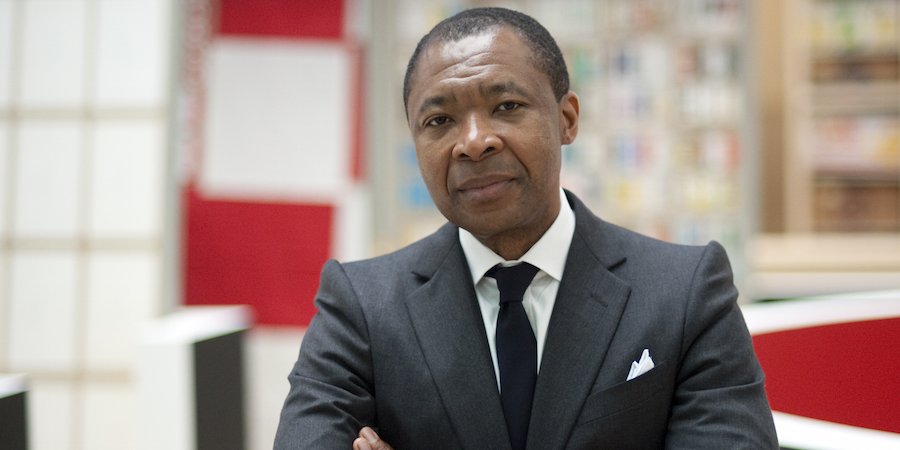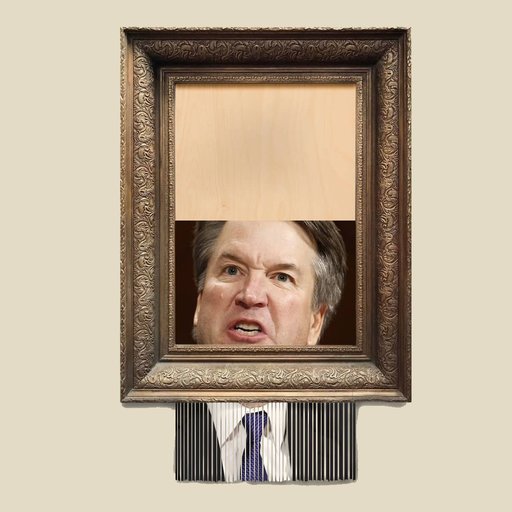How do you represent history? And whose history are you representing? These are the questions at the heart of Okwui Enwezor’s flagship exhibition for the 56th Venice Biennale—and if the language they are posed in might seem a trifle academic, the fiery indignation underlying them is unmistakable. The title of the exhibition is “All the World’s Futures,” to which the viewer might as well add the words “Are at Stake.” This is a timely show, and a frighteningly necessary one.
It is significant that Enwezor, of African descent, comes to the exhibition with a personal and professional history that is new to the Biennale. Born in Nigeria, he came to New York City during the 1980s to study political science, after which he performed poetry readings at the Nuyorican Poets Café in the East Village and other places, founded the contemporary African art journal Nka, and began curating a prodigious number of shows relating to photography and, often, the way the African experience was documented both at home and in the West. An early landmark was “In/Sight: African Photographers, 1940 to Present” at the Guggenheim, introducing audiences to the work of Samuel Fosso, David Goldblatt, South Africa’s Drum magazine, and other now-famous names.
Now 51 and a distinctly refined dresser whose formal suits hearken back to an earlier era of statesmanlike intellectual glamor (think André Malraux), Enwezor has since amassed an untouchable curatorial resume that includes the Gwangju Biennial, the Paris Triennial, and dOCUMENTA. (He is the only curator other than Harald Szeemann to curate both that behemoth and Venice.) A widely published author, he has also written two highly influential texts, Contemporary African Art Since 1980 (2009, with Chika Okeke-Agulu) and Archive Fever: Uses of the Document in Contemporary Art (2008).
In many ways, this exhibition is a summa of Enwezor’s career. Now the director of Munich’s Haus der Kunst, he has said he will not curate another biennial after this one, and his intellectual autobiography can be read through his choices in the show. Spread between the Giardini and the Arsenale, it features 136 artists from 53 countries, many of whom will be unfamiliar to even the most seasoned art professionals. Twenty one were born in Africa, 16 in Asia, nine in the Mideast, an unexpected six in Australia, 48 in Europe, and 34 in the Americas (no one in Canada, though). Unlike in many recent biennials, meanwhile, Enwezor has been relatively abstemious when it comes to including deceased artists—which serves the twofold purpose of casting the bulk of emphasis on working artists and of calling special attention to the 10 dead figures he did select. They haunt the Biennale, somewhere between saints and ghosts.
Here are a few things to know about “All the World’s Futures.”
A LOT HAS CHANGED IN TWO YEARS
In 2013, Massimiliano Gioni’s “Encyclopedic Museum” show drew colossal raves from critics—and snipes from academics—for its heartfelt, sweeping, and stirring (if a little blowsy, in retrospect) paean to the unbounded possibilities of the human mind, and its essential universality across time and geography. The period between then and now, as Enwezor has noted, has “been a terrible two years.” There has been the rise of the Islamist force Boko Haram (“Western Education Is Forbidden”) in his native Nigeria, the metastasis of ISIS in the Middle East, Putin’s invasion of Ukraine, a further yawning of the gulf between rich and poor (as diagnosed by Thomas Piketty), the massacre of Charlie Hebdo in Paris, and the extraordinary deterioration of race relations in the United States.
That all of this has happened simultaneously in so short a span is scary, and Enwezor’s show tellingly shifts worldviews 180 degrees from Gioni’s. Instead of celebrating the universality of the human experience, this year’s Biennale focuses on the particularity of human lives—lives that are forcefully shaped by national borders, ethnic and cultural boundaries, and economic pressures. It is also, critically, about how those lives can push back against these forces in protest.
PREPARE TO ENGAGE
This is a show that demands engagement, both from its artists and from its viewers. Enwezor, it should be said, is exasperated by the complacency of the current moment of Zombie Abstraction and spectacular funhouse art. He told the Financial Times: “We expect writers to ponder the big questions, and musicians and composers. But somehow in the current moment the things that are most celebrated in our field are devoid of position. They do their job; they don’t disturb. They don’t raise questions…. There is a lot of painting.” In this show, Enwezor has tapped an impressive number of artists who ignore the market enough to speak truth to power—sometimes to the extent that it’s not obvious that what they’re doing is art.
Their ethos may be best summarized by the Russian artist known as Gluklya, who co-wrote a 2002 manifesto declaring that “The place of the artist is by the side of the weak.” Her work, featured in the show, has been characterized by an exploration of the nature of public and private space Putin’s Russia. Another participant, the artist group Gulf Labor, shines the spotlight on another zone of oppression, the camps of migrant workers who have been essentially in a state of indentured servitude—forced to pay recruitment fees to get jobs, only to find the low wages prevent them from leaving—while laboring on the megamuseums being raised on Saadiyat Island and other campuses on the Arabian Peninsula. The Australian duo Sonia Leber and David Chesworth have similarly used their work to publicize situations they find unjust, including a display in the Sydney Biennial that criticized Australia’s mandatory detention centers—centers run by one of the biennial’s main sponsors.
Several of figures in the show have gone to prison for their activities. Take Abounaddara, a collective of anonymous Syrians who taught themselves how to shoot films and have been posting footage of life in Damascus on Vimeo every Friday since the early days of the uprising against Assad in 2011. One of their members, Osama al-Habali, has been in prison since being arrested at age 24. The Cuban artist Tania Bruguera was invited to contribute a piece featuring footage of Fidel Castro; she has since been jailed in Cuba for a performance in which planned to encourage passersby in a Havana public square to speak into a megaphone without fear of censorship.
The paragon of this brand of engaged art in the show may be the late Egyptian painter and women’s rights activist Inji Efflatoun, who joined a Communist political party at 22 and devoted herself to the cause for 17 years until she was imprisoned for four years by Nasser in 1959. She then resumed her painting, in the hybrid modernist-influenced style of the times, until her death in 1989.
One senses, when it comes to the inclusion of these artists, that their aesthetic components are secondary to their moral and political messages. These are not people who make art that a viewer can breeze by and instantaneously “get,” like a Koons balloon animal. It should be noted that Enwezor himself is not afraid to take on political causes: when Kenya nearly gave over its pavilion to a group of Chinese artists this year, raising a provocative parallel to the incursions of Chinese influence in that country, he lambasted the choice as “a group of unscrupulous artists… hijack[ing] Kenya,” and the plan was dropped.
THE RESIDUE OF HISTORY
Enwezor has said that he was “fundamentally interested in the idea of residue” when assembling this show—the idea that we are continually surrounded by “shadow histories” that weigh on the present, like dark matter. Histories, he believes, are too often misrepresented—as a victor’s narrative, for instance, or with willful lacunae omitting the injustices of the past—and it is the job of artists to ensure that memory is preserved. This is a job that is passionately carried out by many artists in the show.
Sometimes this concerns the pasts of a century ago, as in the case of Madhusudhanan, an Marxist Indian filmmaker and painter whose work ties together the colonial history of his country and its current war footing. Other times it goes further back, as with the artist Melvin Edwards, whose ominous metal sculptures recall the tools used by slaves in America and the brutal masters who chained them.
The Holocaust is a pervasive theme. The late Fabio Mauri was so scarred by the photographs that his father’s news agency received from the camps that he need to be institutionalized for eight years; he then spent the next half century creating art questioning how Europe could have allowed such an atrocity to occur on its shores. Christian Boltanski, too, continues to explore that tragedy today, while the until now little-known late Arte Povera artist Pino Pascali took a more playful approach to the WWII era with his pre-Oldenburg soft sculptures recreating the weapons of war he grew up seeing in Italy. (He died at 32 in a motorcycle accident.)
Hans Haacke, a father of institutional critique, has applied this strategy with a more contemporary viewpoint. His 1993 German pavilion famously cracked the marble floor of the Nazi-architected building into rubble just a few years after the fall of the Berlin Wall and the beginning of reunification; for the Biennale, he has contributed his celebrated opinion polls asking participants how they feel about the sometimes unsavory sources of wealth for the patrons of art causes.
William Faulkner wrote, “The past is never dead. It’s not even past.” That is particularly the case for several artists whose societies are still actively struggling with the burdens of ethnic strife and internecine struggle. The Maputo-based artist Concalo Mabunda, for instance, tweaks the idiom of turning swords into plowshares by sculpting decommissioned weapons from local militias into thrones and ceremonial masks. Hailing from the Democratic Republic of Congo, the photographer Sammy Baloji has created collages that import black-and-white historic photos of colonials and Congolese workers onto the derelict remains of the mine they once built and dug.
The South African draftsman and collagist Kay Hassan creates artworks that explore the personal and political aspects of life in the wake of Apartheid. In a more wistful frame of mind, David Maljković makes films and installations that look back on the avant-garde utopias of Yugoslavia under Tito, questioning what is worth preserving from the authoritarian past and what it means for a formerly regimented people to proceed through history with an uncertain cultural identity.
THIS IS A SHOW THAT IS MARXIST (AND ANTI-MARKET)
For the past century, the koine of the international leftist ideology has been Marxism, and to celebrate this history Enwezor has given over the stateliest chamber in the exhibition’s main pavilion to a live reading of all three lengthy volumes of Das Kapital as a “test,” he has said, of “whether we can treat this as our contemporary Oratorio.” The message this gesture sends is loud and complex. For one thing, it is a call to arms for intellectuals that the creative act—writing, in Marx’s case—can indeed change, or at least modulate, what seem like entrenched sociopolitical orders.
For another thing, it is a rebuke of a runaway economy that waters the rich while parching the poor and, by extension, an art market that rewards agreeable gloss over work that speaks inconvenient truths. It is not an accident that this show features a notable dearth of painting and a profusion of drawings, text, installation, video, film, and other largely non-decorative works that are harder for the market to influence. “The biennial is not commercial,” Enwezor told Coline Milliard in an interview. (Some collectors, on the other hand, may disagree.)
Some of the more notable inclusions in the show that channel this pervasive theme are Andreas Gursky’s supersized photographs of stock-market trading floors around the world, an installation by the committed Marxist installation artist Thomas Hirschhorn, artworks recreating aboriginal bank notes by Newell Harry, and a tribute to factory workers from the 1860s by Jeremy Deller, who last time around featured a now-iconic mural of the mad wallpaperist William Morris hurling Roman Abramovic and Dasha Zhukova’s yacht into the Venetian lagoon.
PUTTING THE MARGINS AT THE CENTER
It’s been 51 years since Robert Rauschenberg’s Golden Lion win at the Venice Biennale cemented the United States’s ascendence to the top of the contemporary art world heap, and Enwezor’s show appears to have set out to fill in the blanks of that triumphalist narrative of the past half century of contemporary art, giving ample attention to the places we have to often overlooked. “Art isn’t just made by white people in Europe with great patrons,” Enwezor told the Wall Street Journal. “Sorry.”
This more than overdue approach brings us people like the late Emily Kame Kngwarreye, one of the most important figures in history of contemporary Indigenous Aboriginal Art, whose work came out of preparing objects for women’s ceremonies but who then learned to work with batik and, later, canvas. It also brings us Ibrahim Mahama, a 28-year-old Ghanaian artist whose gargantuan tapestry of colorful textiles used in his country’s manual-labor industries, like coal mining, is covering an exterior wall of the Arsenale—perhaps an homage of sorts to his fellow Ghanaian artist, El Anatsui, who already won this year’s Golden Lion for lifetime achievement.
Emphatically, Enwezor has also angled this approach at the United States, inviting a phenomenal lineup of black American artists to participate in the show at a time when millions of people across the country find it necessary to protest that “black lives matter.” In addition to Melvin Edwards, this group includes the somehow still underappreciated painter Kerry James Marshall, Glenn Ligon, Charles Gaines, the late Terry Adkins, Adrian Piper, Lorna Simpson, Wangechi Mutu, and Theaster Gates.
IDENTITY AND BORDERS
Across the pond, the New Museum Triennial is considering identity from a speculative standpoint: Is gender fixed? Are bodies necessary? Are objects people too? Here in Venice, Enwezor is taking a far more materialist view of identity, and it’s one in which the body is inscribed by the ethnic and national borders that circumscribe it—unless that body manages to break free.
This is very much the subject of the Invisible Borders Trans-African Photographic, a collective that began in 2009 with the aim of sending convoys of artists, writers, and documentarians on trips across the continent in an effort to burst these boundaries and create common bonds across these artificial, often-imposed national divisions. The exhibitions they create out of their travels imagine an optimistic future where continental brotherhood trumps territoriality. In Europe, the Tomorrow Journal postulates a similarly utopian goal for its continent, where that sprawling and riven cluster of nations is united into a single polycentric city state.
The Vietnamese artist Tiffany Chung, meanwhile, makes tapestries and drawings out of maps that visualize deeply researched data, laying out its social and political implications. But perhaps no artist better exemplifies the vagaries of identity better than the installation artist K. Hiwa, who grew up as a Kurd living in an Arab neighborhood in Iraq until his family was forced by sectarian pressures to move to a Kurdish area—where he was persecuted for his former Arab address. Now living in Berlin in political asylum, Hiwa is someone whose oppressive context was no match for the indomitability of his art.
























